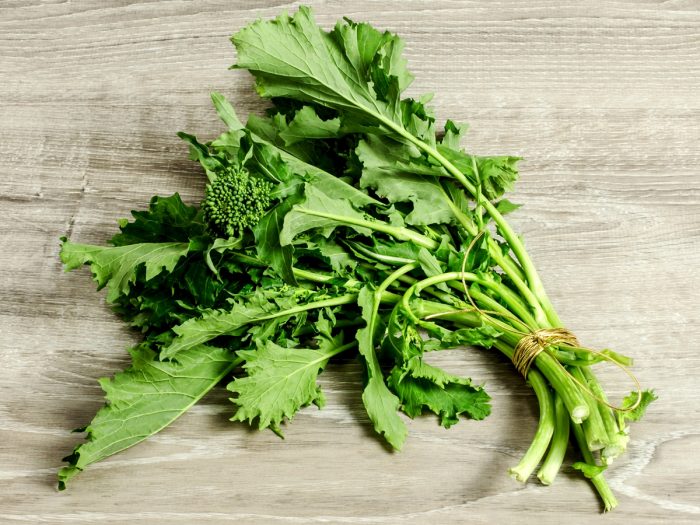You have certainly had broccoli before but broccoli rabe is less commonly found on a dinner plate. This nutrient-packed vegetable with a recognizable name has several surprising nutrients and potential health benefits. So if you are looking for an interesting new addition to your diet, the broccoli rabe is an excellent choice.
What is Broccoli Rabe?
Broccoli rabe is a cruciferous vegetable closely related to turnips than to broccoli, despite its name. The plant looks like it has long broccoli stalks, topped with large leaves that almost resemble spinach. The stalks, flowers, and leaves are all edible on this vegetable, which bears the scientific name Brassica rabe. Also known as rapini in certain parts of the world, this vegetable has been popular in China for generations, as well as in Italy, but it has only recently entered the United States.
The taste of this vegetable is slightly bitter, and it is commonly mixed in with pasta, particularly in traditional Italian dishes. Aside from its flavor, which is somewhat similar to broccoli, it has a unique nutrient profile that makes it quite desirable to those looking for healthy vegetable options. [1]

Broccoli rabe is a superfood packed with vitamins and nutrients to fuel your meal. Photo Credit: Shutterstock
Serving Size : Nutrient Value Water [g] 91.41 Energy 25 Energy [kJ] 104 Protein [g] 3.83 Total lipid (fat) [g] 0.52 Ash [g] 1.11 Carbohydrate, by difference [g] 3.12 Fiber, total dietary [g] 2.8 Sugars, total including NLEA [g] 0.62 Sucrose [g] 0.15 Glucose (dextrose) [g] 0.23 Fructose [g] 0.24 Calcium, Ca [mg] 118 Iron, Fe [mg] 1.27 Magnesium, Mg [mg] 27 Phosphorus, P [mg] 82 Potassium, K [mg] 343 Sodium, Na [mg] 56 Zinc, Zn [mg] 0.54 Copper, Cu [mg] 0.08 Manganese, Mn [mg] 0.38 Selenium, Se [µg] 1.3 Vitamin C, total ascorbic acid [mg] 37 Thiamin [mg] 0.17 Riboflavin [mg] 0.14 Niacin [mg] 2.02 Pantothenic acid [mg] 0.45 Vitamin B-6 [mg] 0.22 Folate, total [µg] 71 Folate, food [µg] 71 Folate, DFE [µg] 71 Choline, total [mg] 33.6 Betaine [mg] 0.2 Vitamin A, RAE [µg] 227 Carotene, beta [µg] 2720 Vitamin A, IU [IU] 4533 Lutein + zeaxanthin [µg] 1683 Vitamin E (alpha-tocopherol) [mg] 2.53 Tocopherol, beta [mg] 0.01 Tocopherol, gamma [mg] 0.32 Vitamin K (phylloquinone) [µg] 256 Fatty acids, total saturated [g] 0.09 16:0 [g] 0.08 18:0 [g] 0.01 Fatty acids, total monounsaturated [g] 0.05 17:1 [g] 0.03 18:1 [g] 0.02 Fatty acids, total polyunsaturated [g] 0.23 18:2 [g] 0.03 18:3 [g] 0.2 Tryptophan [g] 0.05 Threonine [g] 0.13 Isoleucine [g] 0.13 Leucine [g] 0.21 Lysine [g] 0.24 Methionine [g] 0.06 Cystine [g] 0.05 Phenylalanine [g] 0.15 Tyrosine [g] 0.09 Valine [g] 0.18 Arginine [g] 0.21 Histidine [g] 0.08 Alanine [g] 0.15 Aspartic acid [g] 0.43 Glutamic acid [g] 0.66 Glycine [g] 0.15 Proline [g] 0.16 Serine [g] 0.12 Sources include : USDA [2]
Broccoli Rabe (Rapini) Nutrition Facts
Broccoli rabe is a rich source of vitamin C, vitamin K, vitamin A, and glucosinolates, as well as iron, folate, calcium, magnesium, potassium, and zinc. There is also a decent amount of dietary fiber and even trace amounts of omega-3 fatty acids. Most impressive is the low level of calories – only 9 calories in one cup of this nutritious vegetable.
Health Benefits of Broccoli Rabe
There are quite a few health benefits to broccoli rabe, including reducing cardiovascular risk, strengthening bone mineral density, preventing certain cancers and managing blood sugar levels, among others.
Controls Diabetes
With high levels of dietary fiber, broccoli rabe is an excellent tool for lowering blood sugar, as fiber can control the release of insulin and glucose in the body. According to a study in the International Journal of Food Sciences and Nutrition, broccoli sprouts may improve insulin resistance in type-2 diabetic patients. [3] [4]
Improves Bone Strength
With moderate levels of magnesium, calcium, iron, zinc, and potassium, this vegetable is capable of strengthening bones and preventing the onset of osteoporosis, when consumed regularly. [5]
Protects Heart Health
Some of the active ingredients in broccoli rabe can lower levels of homocysteine, which can contribute to cardiovascular problems, high blood pressure, and degradation of blood vessels and arteries. [6]
Anticancer Potential
Research has linked the antioxidants found in Brassica vegetables to lower levels of cancer. The phytochemicals in broccoli rabe are particularly important for lowering inflammation and oxidative stress in the body. [7]
Lowers Neural Tube Defects
There is a high level of folate in broccoli rabe, which is a key vitamin linked to lowering neural tube defects in pregnant women. [8]
Difference between Broccoli, Broccolini & Broccoli Rabe
Despite having similar names, appearances, and flavors, these three types of vegetables belong to different taxonomic families. They are each considered Brassica vegetables (leafy greens), but many of the technical similarities stop there.
Broccoli
Commonly known as Brassica oleraceae italica, this vegetable has a thick stalk and dense florets, and is versatile in cooking around the world, but can also be eaten raw.
Broccolini
This is a hybrid between regular broccoli and Chinese kale, which gives broccolini long, slender stalks, unlike the short squat ones of broccoli. The florets are also smaller in this hybrid variety, and there are more leaves. [9]
Broccoli Rabe
Scientifically known as Brassica rapa, this vegetable belongs to the turnip family and has long, thin stalks and healthy, dark green leaves, all of which can be eaten. [10]
How to Cook Broccoli Rabe?
The best way to cook this vegetable is to blanch the leaves first. You do this by adding the leaves to a pot of salted water that has been brought to a boil. Allow the leaves to come back up to a boil for 1-2 minutes, then strain the leaves out. At this point, you can add the broccoli rabe leaves to pasta sauces and meat dishes, as well as other vegetable sides. Many people like to steam or sauté broccoli rabe, which can help overcome some of the bitterness.
